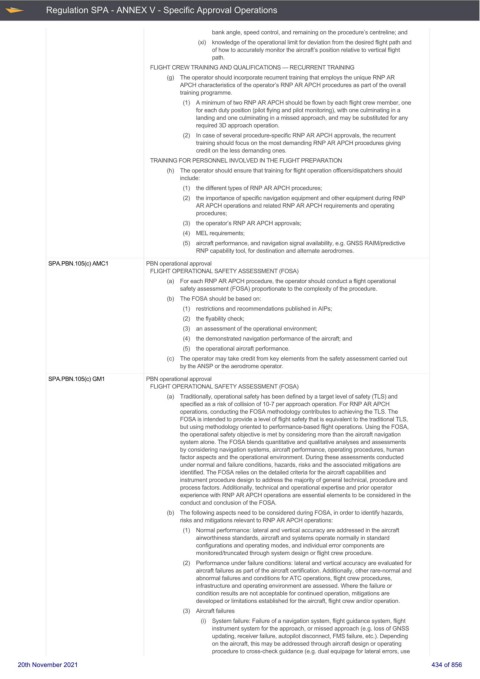Page 434 - UK Air Operations Regulations 201121
P. 434
~
~ Regulation SPA - ANNEX V - Specific Approval Operations Centrik
bank angle, speed control, and remaining on the procedure’s centreline; and
(xi) knowledge of the operational limit for deviation from the desired flight path and
of how to accurately monitor the aircraft’s position relative to vertical flight
path.
FLIGHT CREW TRAINING AND QUALIFICATIONS — RECURRENT TRAINING
(g) The operator should incorporate recurrent training that employs the unique RNP AR
APCH characteristics of the operator’s RNP AR APCH procedures as part of the overall
training programme.
(1) A minimum of two RNP AR APCH should be flown by each flight crew member, one
for each duty position (pilot flying and pilot monitoring), with one culminating in a
landing and one culminating in a missed approach, and may be substituted for any
required 3D approach operation.
(2) In case of several procedure-specific RNP AR APCH approvals, the recurrent
training should focus on the most demanding RNP AR APCH procedures giving
credit on the less demanding ones.
TRAINING FOR PERSONNEL INVOLVED IN THE FLIGHT PREPARATION
(h) The operator should ensure that training for flight operation officers/dispatchers should
include:
(1) the different types of RNP AR APCH procedures;
(2) the importance of specific navigation equipment and other equipment during RNP
AR APCH operations and related RNP AR APCH requirements and operating
procedures;
(3) the operator’s RNP AR APCH approvals;
(4) MEL requirements;
(5) aircraft performance, and navigation signal availability, e.g. GNSS RAIM/predictive
RNP capability tool, for destination and alternate aerodromes.
SPA.PBN.105(c) AMC1 PBN operational approval
FLIGHT OPERATIONAL SAFETY ASSESSMENT (FOSA)
(a) For each RNP AR APCH procedure, the operator should conduct a flight operational
safety assessment (FOSA) proportionate to the complexity of the procedure.
(b) The FOSA should be based on:
(1) restrictions and recommendations published in AIPs;
(2) the flyability check;
(3) an assessment of the operational environment;
(4) the demonstrated navigation performance of the aircraft; and
(5) the operational aircraft performance.
(c) The operator may take credit from key elements from the safety assessment carried out
by the ANSP or the aerodrome operator.
SPA.PBN.105(c) GM1 PBN operational approval
FLIGHT OPERATIONAL SAFETY ASSESSMENT (FOSA)
(a) Traditionally, operational safety has been defined by a target level of safety (TLS) and
specified as a risk of collision of 10-7 per approach operation. For RNP AR APCH
operations, conducting the FOSA methodology contributes to achieving the TLS. The
FOSA is intended to provide a level of flight safety that is equivalent to the traditional TLS,
but using methodology oriented to performance-based flight operations. Using the FOSA,
the operational safety objective is met by considering more than the aircraft navigation
system alone. The FOSA blends quantitative and qualitative analyses and assessments
by considering navigation systems, aircraft performance, operating procedures, human
factor aspects and the operational environment. During these assessments conducted
under normal and failure conditions, hazards, risks and the associated mitigations are
identified. The FOSA relies on the detailed criteria for the aircraft capabilities and
instrument procedure design to address the majority of general technical, procedure and
process factors. Additionally, technical and operational expertise and prior operator
experience with RNP AR APCH operations are essential elements to be considered in the
conduct and conclusion of the FOSA.
(b) The following aspects need to be considered during FOSA, in order to identify hazards,
risks and mitigations relevant to RNP AR APCH operations:
(1) Normal performance: lateral and vertical accuracy are addressed in the aircraft
airworthiness standards, aircraft and systems operate normally in standard
configurations and operating modes, and individual error components are
monitored/truncated through system design or flight crew procedure.
(2) Performance under failure conditions: lateral and vertical accuracy are evaluated for
aircraft failures as part of the aircraft certification. Additionally, other rare-normal and
abnormal failures and conditions for ATC operations, flight crew procedures,
infrastructure and operating environment are assessed. Where the failure or
condition results are not acceptable for continued operation, mitigations are
developed or limitations established for the aircraft, flight crew and/or operation.
(3) Aircraft failures
(i) System failure: Failure of a navigation system, flight guidance system, flight
instrument system for the approach, or missed approach (e.g. loss of GNSS
updating, receiver failure, autopilot disconnect, FMS failure, etc.). Depending
on the aircraft, this may be addressed through aircraft design or operating
procedure to cross-check guidance (e.g. dual equipage for lateral errors, use
20th November 2021 434 of 856

